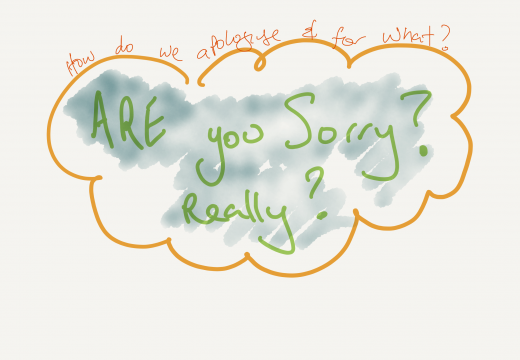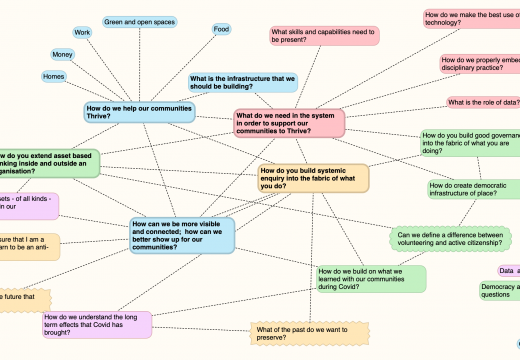In my last post I talked about why I believe our leaders need be able to think strategically about what it means to be digital by default if we are going to use the power of digital networked technologies to transform the way we live. This post is about the the counterweight to this – the issue of digital exclusion. I am often out in the world evangelising about the opportunity which the network society offers us – but this work needs to be balanced by an equal effort to make sure everyone can participate. Having done a lot of presenting recently I wanted to reacquaint myself with the facts about digital exclusion to make sure that I am taking both of these messages out and about with me.
For the majority of us digital exclusion is not an issue as internet use continues to rise. According to the latest ONS figures (Internet Access Quarterly Update, 2012 Q1) only 8.12 million adults (16.1 per cent) had never used the Internet and this is about 1 per cent lower than 2011 Q4 and 7 per cent lower than 2011 Q1.
“At 2012 Q1 there were 42.16 million adults in the UK who had ever used the Internet, representing 83.7 per cent of the adult population. The 8.12 million adults who had never used the Internet represented 16.1 per cent of the adult population.”
However within these figures is the real issue:
“Of those adults in employment whose gross weekly pay was less than £200 per week, 6.9 per cent (367,000) had never used the Internet. Internet use has almost reached full coverage for those earning in excess of £500 a week, with Internet use nearly 99 per cent for all adults with weekly pay rates above this level.”
Digital exclusion, as with any form of exclusion, is a complex issue but clearly income and the ability to purchase access is a central element. Other elements include educational attainment, technical skills, social pressures, physical ability and at the heart of it your motivations (or lack of) for going online. This last one is critical – many people will fight to overcome other barriers if we help them find a reason to go online – this is one of the many reasons why I think the Social Media Surgery approach is so brilliant as a way of getting people online.
The 2011 OFCOM report into media use and literacies (next one due in August) indicates the growth in internet use and shows increases in the variety of uses made of the internet but also warns:
There continue to be significant differences by age and socio-economic group across a variety of measures. And those that aren’t online are more likely to be older and from DE socio-economic groups – some 51% of those aged 65+ say they don’t intend to get the internet at home, and 29% of those in DE socio-economic groups, compared to 15% of the UK population as a whole.
The concern about new kinds of digital exclusion is being explored as part of a Nominet Trust funded project at the OII. The project is looking into ‘lapsed’ internet use in what they believe is around 10% of young people in Britain. The research is ongoing but you there is a really useful literature review here:
What does this all mean?
Looking at this issue again it is fairly striking that the policy research on this that is being referenced in Government is a couple of years old. We are talking about 2008 in terms of the CLG and 2009 in reference to the background info that formed the evidence for the Race Online Campaign (you can see the report here). I have not been able to find anything more recent and would be grateful if anyone can point me in the direction of anything more relevant.
This point is picked up more broadly in this post by Ellen Helsper on the LSE Politics Blog . Ellen concludes:
“To achieve a digitally equal Britain as well as a digital Britain, policies need to set targets for the whole spectrum of digital inclusion: quality of access, skills, motivations and effective, sustainable use. It is irresponsible to think that the latter can be handed over to industry or the third sector completely. Just as standards are set for education standards need to be set for digital inclusion across government departments and policies.”
There is a game changer at hand however in the form of the smart phone: 45 per cent of Internet users used a mobile phone to connect to the Internet (ONS / ONS Internet Access 2011) and we know from OFCOM data that smartphone purchases are on a sharp rise to over 50% of contracts now being taken up (this data is all referenced here on the facts glorious facts page). The smart phone take up is also vulnerable to financial pressure and the adoption curve for new technology may well slow in the face of economic hardship – though I have heard a lot of anecdotal evidence from practitioners who say that they are finding that people will continue their phone contract in preference to their rent or food which is worrying.
Sitting behind all of these factors are questions of broadband and 3G coverage – you can be rich as Croesus and have 3 PHDs but this will do you little good if you can’t actually connect to the internet.
Some conclusions
The strategy of being Digital by Default is undoubtedly supported by the evidence base – its also in my view vital if we want to ensure economic relevance for the country in the future. If we look at the evidence in the round I think we can have reasonable confidence that the increase in smart phone technology and the consistent pattern of increases in internet use make this a diminishing problem – albeit one with a long tail. However there are also signs that there will be a group of people who are persistently excluded for a number of complex reasons as is the case with other forms of social exclusion. What does this mean for policy making? I have three thoughts on this:
- We need to make sure that we have 100% fast broadband coverage throughout the Country otherwise digital by default is an empty promise
- We need to keep the question of digital exclusion alive in the planning and policy process and to look at specific groups who will be effected – we are not yet at the point where we can assume everyone is online
- I think we need to refresh the evidence base in order to understand exactly what effect smartphone take up is having on digital exclusion
I think my final question is to ask where we think that this responsibility is sitting? The Race Online project was an effective start but I am not seeing that work being picked up with the same energy now and I am also seeing some fairly limp broadband campaigns from a number of Local Authorities (naming no names) which says to me the message has not really hit home. I am hoping that I am missing some and that there is good work going on to address this issue – if you know of something can you let me know?
I think we are at a really pivotal moment with respect to where technology might take us. The promise of Open Data and Digital by Default on the one hand, the fact that the online space is still dominated by commercial rather than social forces and as a result excludes people on the other. Linking back to my post of earlier today – we need to make sure that our leaders really are thinking digital on behalf of the people who are not yet there.




Pingback: Re-examining the digital divide | « B&NES JSNA |
Nshimbi
An interesting article. One question though do we need to pursue the Broadband agenda or is the move to mobile and the ability to deliver web content through digital TV meaning that we’re investing a great deal of expenditure where it might not be necessary? The barriers to entry for mobile and TV are much lower than Broadband and PC as many people already have one or both of the devices.